The 10 Brands People Feel Most Intimately Connected to in 2022
Disney, Tesla, and Apple are the major brands people feel most intimately connected to, according to recent research from MBLM.
The report was based on an analysis of more than 600 well-known global brands across 19 industries. The researchers used AI to analyze more than 1.4 billion keywords and social media mentions of the brands to determine sentiment. Each brand was then assigned a Brand Intimacy Quotient score from 0 to 100, with a higher score reflecting a more intense emotional relationship (see the full methodology here).
Disney is the most "intimate" brand overall, the researchers found.
Tesla ranks second, followed by Apple, Sony, YouTube, Mercedes-Benz, Trader Joe's, Netflix, Android, and Sega.

Among the industries examined, people feel most intimately connected to media/entertainment brands and tech/telecom brands.
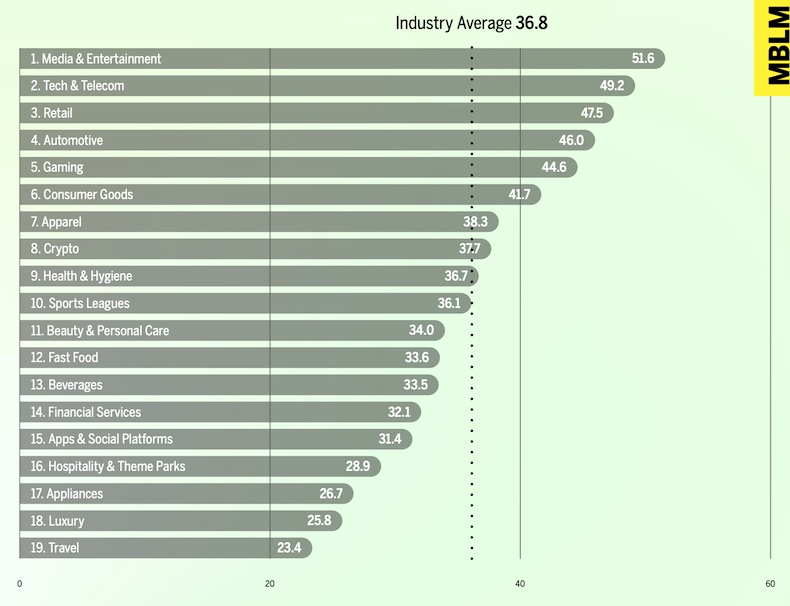
Fostering intimate connections with people has a strong financial payoff, the researchers found. The top 20 brands on last year's brand intimacy list saw a 44% jump in their end-of-year stock prices between 2020 and 2021, compared with a 32% increase for companies on the Fortune 500 list.

Read the original article from Marketing Prof
Mental Health Awareness Month: It's a family affair

Parents of children struggling with mental health face several byproducts which can impact their performance at work and just daily life. According to Brightline data, if your child has a mental health issue, you’re twice as likely to have one yourself. Tebben says there’s also a 50% greater chance of divorce if your child has a mental health issue. During the pandemic, 48% of parents considered getting help or had gotten help for their children. However, 21% either left or considered leaving their job because of their child’s behavioral health condition.
That’s a wake-up call for employers during the Great Resignation, in which companies across the United States are experiencing historic turnover. More than 60 million Americans have quit their jobs over the past year, according to the U.S. Bureau of Labor Statistics. Prompted by the pandemic to re-evaluate their priorities in life, workers have been leaving their positions for greener pastures, demanding higher salaries, better working conditions, improved work-life balance and more opportunities to advance their career.
To combat the nationwide staffing shortage and compete for talent, employers are having to increase their compensation and benefits packages beyond the traditional healthcare, dental, vision and 401(k) offers. Mental health benefits, resources and support for not only themselves, but also their families, remain in high demand by job seekers.
“The feedback across the board indicates that it’s not a year of take away – it’s a year of how do we add support to get employees back to the office,”
Read the original article here
Why You Need A Great CHRO (Now More Than Ever)

With the elevation of the human resources function to the C-Suite in recent years, the relationship between CEOs and Chief Human Resources Officers has become increasingly important for the effective management of companies. That trend exploded when the Covid-19 pandemic and subsequent disruptions in labor markets further emphasized the importance of human resources to enterprises’ strategic success.
“Every company has its mission and core values: We care about people, people first, all that,” says Omni Hotels and Resorts CHRO Joy Rothschild. “The pandemic forced people to the top priority every single day in a way that companies had never had to deal with before.” As a result, the relationship between CEOs and HR leaders has in many cases transformed over the last two years.
“When I think about pre-pandemic, it was so much more transactional,” says Nicole Hopkins, former Interim Head of People at Webflow and founder of HR consultancy Up & to the Right Consulting. “It would be CEO X encountering a people issue or a scaling issue and saying, ‘What is your playbook solution to that? What is the best practice?’” The pandemic forced CHROs and CEOs to have much closer partnerships as they had to confront the simultaneous public health and economic crises.
Read the original article from ChiefExecutive.net
Cloud adopters hobbled by 'on-premises computing' mindset: McKinsey

Dive Brief:
- Some CFOs and their C-suite colleagues botch the move to cloud computing because they hold on to an outdated financing and management mindset that took root during years of managing on-premises technology, McKinsey said.
- “That thinking has proven hard to change for many companies, with economic and financial models grounded in decades of traditional IT practices that are based on ‘owning’ IT instead of ‘consuming’ it,” McKinsey said.
- “Companies are developing business cases, negotiating contracts and making economic calculations that don’t take into account the different financial approaches and models that are specific to the cloud,” McKinsey said.
Dive Insight:
The costs to companies from missteps in cloud transitions may grow with the rapid pace of cloud adoption.
Worldwide spending on public cloud services will surge 20% this year to $495 billion and 21% next year to $600 billion, according to Gartner. Cloud application services is the biggest segment, with total outlays likely to hit a record $110 billion this year and $136 billion in 2023.
McKinsey identified six “persistent and pernicious” mistakes in cloud adoption:
1/ Rushing to “Day One” benefits
Taking a “lift and shift” approach to moving applications to the cloud, companies yield quick gains from reduced hosting, storage and maintenance costs, McKinsey said.
Yet companies that rush the transition and fail to plan for subsequent months retain many of the technical and operational inefficiencies of the migrated applications and forgo the advantages from the cloud’s flexible infrastructure.
Read the original article from CFO DIve
JSCM Video: Climate change - It’s a supply chain issue
Editor’s note: This video is collaboration between the Journal of Supply Chain Managementand Supply Chain Management Review. Each month, we bring SCMR readers a video interview from the pages of JSCM.
Earlier this spring, the Journal of Supply Chain Management launched a three-part series on climate change and the supply chain. One look at the annual reports of most publicly-traded companies reveals that combating climate change has become a focus of ES&G initiatives, and that supply chains, especially global supply chains, can play a vital role in a company’s strategy. Afterall, this is a topic that impacts everyone and can have detrimental spillover effects on international markets, trade and tourism.
In this series, JSCM’s aim is to increase scholarly attention to this topic. The first episode examines why the supply chain academic community should in engage in climate change research. Episode 2, available by clicking here, looks at some examples of research questions that supply chain scholars could consider investigating on climate change.
In this, the third episode, the JSCM team offers suggestions as to how can supply chain scholars move forward from a research methods and data sources perspective.
Be sure to click on the video.
You can access Video 1 by clicking here.
You can access Video 2 by clicking here.
The Importance of Emotional Intelligence in the Workplace
Key Insights
- Emotional Intelligence or Emotional Quotient (EQ) is a social intelligence with which we recognize and process emotions, ultimately allowing us to use emotions intelligently to guide decision making in ourselves and others.
- In 2020, the World Economic Forum reports that emotional intelligence is one of the top fifteen most critical skills for workers and leaders in today’s world.
- While emotional intelligence starts with an awareness and regulation of ourselves, the other half of the picture is how we understand and handle emotions in others, which is very important for leaders
When we talk about intelligence, we often think in terms of knowledge, memory, and creativity. After all, our intelligence has been measured over the years in various academic and work settings, all to do with what we remember, what we know, and our ability to express it.
But there’s another aspect of intelligence out there that is equally important—emotional intelligence. And when it comes to emotional intelligence in the workplace, we as leaders would do well to understand this critical aspect of performance.
What Is Emotional Intelligence?
Emotional Intelligence or Emotional Quotient (EQ) is a social intelligence with which we recognize and process emotions, ultimately allowing us to use emotions intelligently to guide decision making in ourselves and others.
Read the original article from Dale Carnegie
5 Risky Imbalances That Keep Businesses From The Results They Expect

Often the simplest principles create conditions for success. Balance is one those principles. One of my earliest teenage jobs was as a server. Servers learn right away that you cannot carry a tray of drinks if all the drinks are on one side of the tray. Unbalanced, they will fall every time. Basic and perhaps obvious, right?
This basic principle of balance is also applied in big business every day. A cargo ship can’t have all of its cargo on one side, or it will sink. An aircraft cannot have all the passengers and luggage on one side, or it will be unsafe to fly. Professional sports teams cannot have only offense or only defense, or they won’t be able to advance the ball and score. Yet so many organizations lack balance.
• They lack balance in having enough of the right people in the right seats to execute on their business goals.
• They lack balance in diversity, equity, inclusion and belonging. Beyond that though, they lack diversity of thought. In many organizations, group think ruins the culture and prevents growth.
• They lack balance in where they work. Hybrid work is the norm. But that environment is so much more challenging to manage and lead than a completely virtual or a completely on-premises entity.
Read the original article from ChiefExecutive.net
The Podcast Boom: Audience and Content Trends
People who listen to podcasts daily say over the past two years they have been listening to podcasts more frequently and have also been listening to more titles, according to recent research from Nielsen.
The Podcasting Today: Insights for Advertisers report was based on a combination of Nielsen data and third-party data.
Some 56% of daily podcast listeners say they have been listening to podcasts more frequently in the past two years, and 52% say the number of podcasts they listen to has increased.
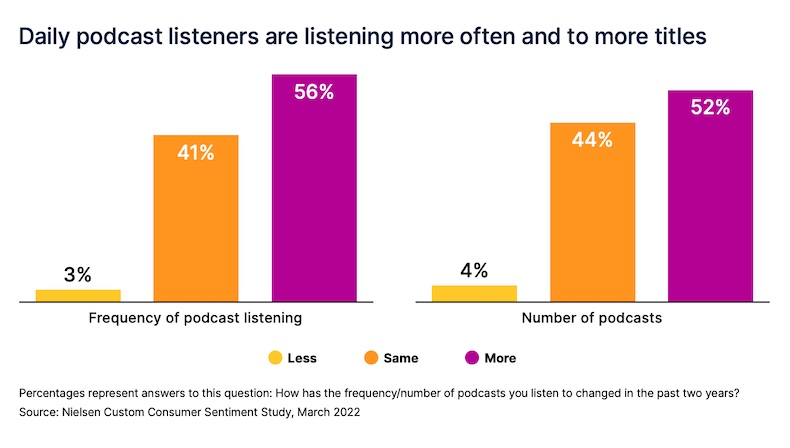
Just over half (51%) of daily podcast listeners say they started listening in the past two years.
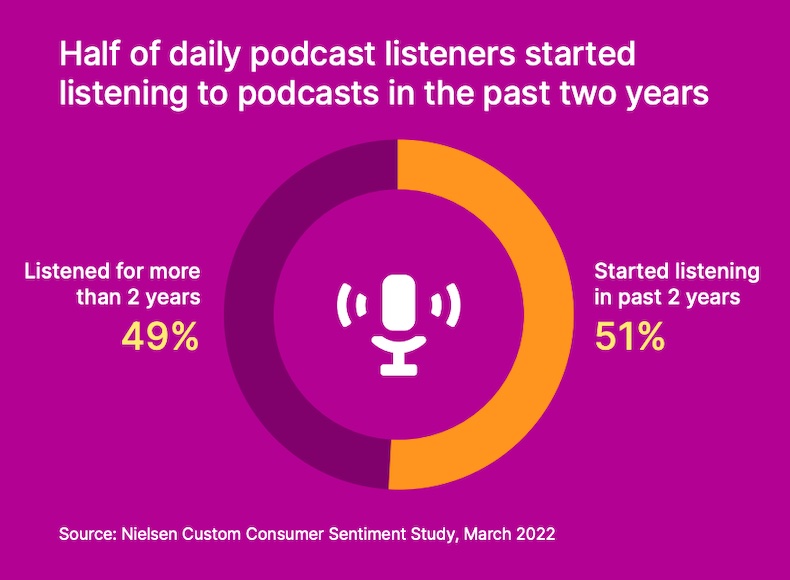
According to Gracenote Audio On-Demand data, as cited by Nielsen, audiences now have more than 2 million podcast series and nearly 92 million episodes to choose from, up 163% and 173%, respectively, in just two years.
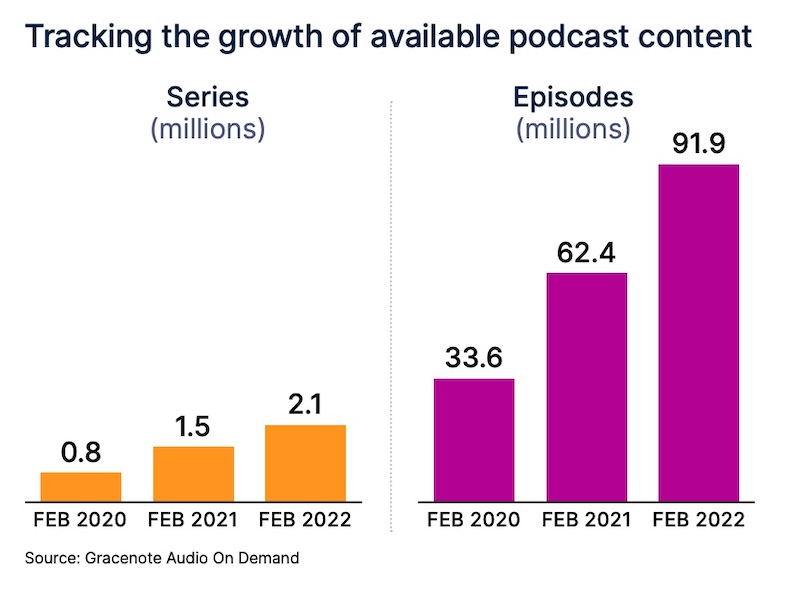
Most podcast listeners say they have resumed pre-COVID activities such as shopping for groceries in store, driving, and getting together with friends and family.
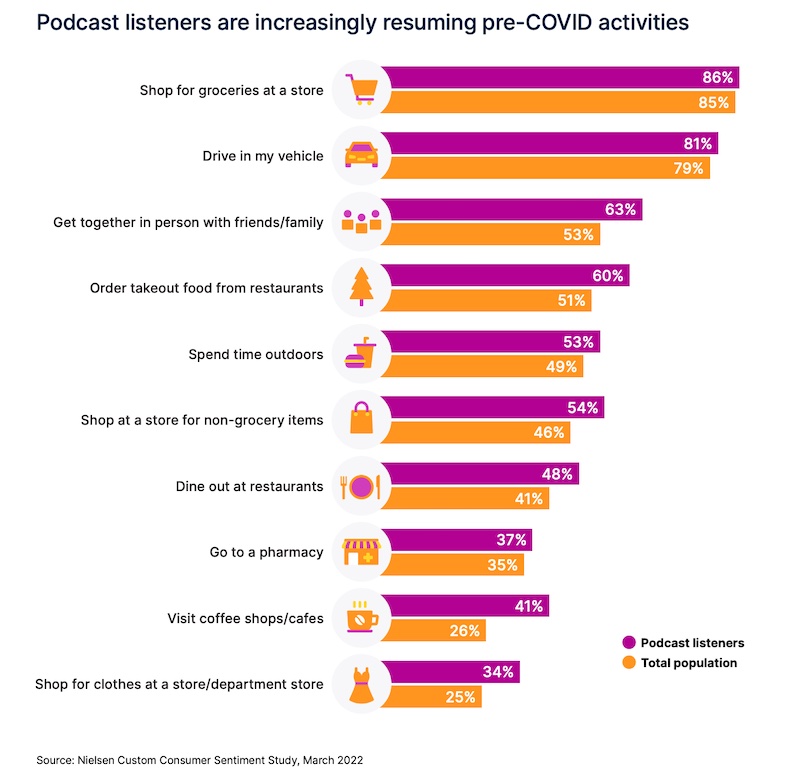
About the research: The Podcasting Today: Insights for Advertisers report was based on a combination of Nielsen data and third-party data.
In Poll, Majority of CEOs Say Hybrid Work Is Here to Stay for 2022. Full Virtual? Not so Much
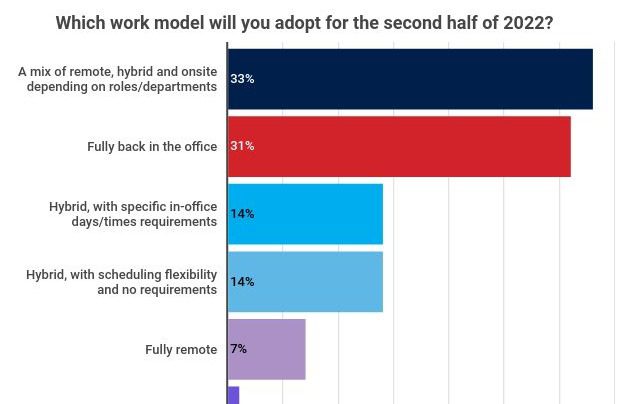
“We have great IT remote and onsite capabilities,” says Michael Lowry, CEO at Lowry Solutions, a mid-size tech company. “This has been critical to our success both during Covid and now our hybrid work environment.” He also shares what else can be done, “We also have a twice monthly festive group lunch and celebration.”
Celebrating and appreciating your employees is important too. To be celebrated, there has to be clear and constant communication, especially in remote settings, CEOs emphasize.
“Narrate your leadership; tell your employees what you are doing and why. It used to be observable, for those interested. Now, working remotely, they can’t see it often enough to glean what you are doing from your actions, so tell them,” says Gary Minor, executive director of 21st Century Leadership Institute, a small professional services firm utilizing a flexible hybrid model without requirements.
The CEO at a small consumer manufacturing firm says to “regularly appreciate your employees and engage in constant communication,” when managing in a hybrid setting.
“Setting clear expectations and making sure the staff has the tools and training necessary to empower them to do good work, along with giving them a sense of ownership, have all been key to our success,” says the CEO of a wholesale/distribution firm that is fully remote.
It is also key to increase the value for your employees and make them feel as though they are an important part of the team, especially when the team is scattered.
Read the original article from ChiefExecutive.net
One-third of Gen Z, millennials take time off due to mental health

According to the Pew Research Center, Gen Z was the generation expected to inherit a strong economy with record-low unemployment. However, due to the COVID-19 pandemic, the generation faces an uncertain future. That’s why a third of millennials and Gen Z respondents have taken time off due to work stress and anxiety, according to a recent Deloitte survey. Meanwhile, 40% feel their employers did a poor job of supporting their mental well-being during the pandemic.
A company that promotes a work-life balance is something that Gen Z applicants are after. Allowing employees to create healthy boundaries on how much they work keeps them mentally and physically fit. Companies can achieve this by encouraging employees to use their leave credits, cultivating a workplace culture that is mindful of employees' workloads and deadlines and offering wellness programs like employee assistance programs (EAPs).
In fact, EAPs may just be the most powerful tool employers have to meet the diversified needs of their employees. According to MetLife data, employees who were offered an EAP by their employer were 34% more likely to say their mental health has improved in the last 12 months and 18% more likely to feel holistically healthy.
EAPs have risen in popularity over the past two years. They provide counseling, referrals, assessments and follow-up check-ins for employees dealing with a multitude of issues: drug abuse, alcoholism, financial problems, legal troubles, job stress, personal problems, separation and loss and family violence.
Read the original article here